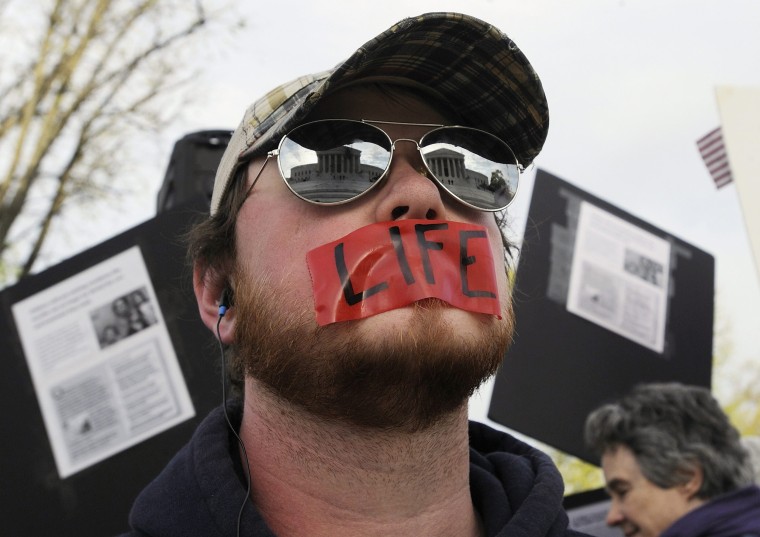The end goal of the anti-abortion movement in America has never been a series of incremental, piecemeal abortion restrictions in red states: Their objective is nothing less then a U.S. Supreme Court decision overturning Roe v. Wade and, preferably, federal legislation making abortion illegal even in states, like New York or California, that would keep it legal in the absence of Roe.
But first, they need a Supreme Court majority sympathetic to the idea that Roe should be overturned, and a state-level abortion ban through which to challenge the landmark 1973 decision. And, in a post-Gorsuch Court in a post-Trump America, they seemingly feel they may have found it.
Not that Mississippi was ever a state to fear blatantly passing unconstitutional abortion restrictions. In 2011 it became the third state to try (and fail) to ban abortion completely via voter referendum. Current Republican Governor Phil Bryant has unabashedly stated that his “goal is to end abortion in Mississippi,” and he nearly succeeded in 2012, by signing a bill to shutter the state’s only abortion clinic with a medically unnecessary requirement demanding the clinic’s doctors have admitting privileges to a local hospital.
What makes Mississippi’s actions so notable is that, prior to 2016, most mainstream abortion opponents were deeply divided over the idea of passing laws that violated Roe so directly.
In that case, Mississippi ended up with a long, protracted court battle that they eventually lost in the wake of Whole Women’s Health v. Hellerstedt, the Supreme Court case that found that closing clinics solely on the grounds of a lack of transfer agreements constituted an undue burden on the right of a pregnant person to seek an abortion. Now almost a year later Governor Bryant is queuing up yet another blatantly unconstitutional abortion restriction, and hoping to bring Roe v. Wade down with it.
Mississippi’s new blanket ban on abortion after 15 weeks gestation (i.e., 15 weeks after a pregnant person’s last period began) is not the most restrictive abortion law passed in the country. States have passed far earlier abortion bans — 12 weeks in Arkansas and six weeks in North Dakota. Those laws, however, were quickly struck down by courts as a violations of Roe for banning abortion completely in the first trimester.
Roe does allow states to restrict abortion starting in the second trimester (about 13 or 14 weeks), but only if the restrictions would somehow protect the health or well-being of the person seeking to end the pregnancy. What a state cannot do is completely ban abortion prior to viability (about 23 or 24 weeks gestation, but specific to each pregnancy). Mississippi’s new law would do exactly that by banning abortion after 15 weeks gestation, with no exceptions for survivors of sexual assault or even to protect a pregnant person’s health.

What makes Mississippi’s actions so notable is that, prior to 2016, most mainstream abortion opponents were deeply divided over the idea of passing laws that violated Roe so directly. The more extreme bans were often blocked by mainstream anti-abortion organizations like National Right to Life or the Susan B. Anthony List, who didn’t want to see a legal challenge that could potentially uphold Roe again.
In 2018, that cautious approach appears to be over, and it’s clear why: Anti-abortion groups no longer fear that the Supreme Court, given its current and future mix of justices, will uphold Roe if another case makes its way there.
For instance, rumors are again swirling that Justice Anthony Kennedy — an appointee of Republican President Ronald Reagan and the acknowledged “swing vote” of the Supreme Court bench — is considering retirement as early as this summer.
Were Kennedy to be replaced by any potential Trump appointee, it is no exaggeration to say there will be a completely new landscape in the U.S. when it comes to accessing a legal abortion.
That may be the wishful thinking of vulnerable GOP senators hoping desperately to encourage a demoralized base to come out in the midterm elections. But whether Kennedy is retiring in time for the midterms or stays another few years, it is very unlikely the 81-year-old justice will serve out the entirety of an eight-year Donald Trump presidency.
For abortion opponents, that means a shift from planning state legislative strategies for the SCOTUS that they have – passing incremental restrictions they think can pass muster under a reasonably restrictive judicial interpretation of Roe — to planning for the SCOTUS they would like to and may well see.
“Chief Justice John Roberts becomes the new swing vote,” warns Jessica Mason Pieklo, legal analyst for Rewire.news (and a co-author of my book, “Crow After Roe”). Roberts, an appointee of Republican President George W. Bush, is considered to be a firm member of the conservative wing of the Supreme Court, and the idea of him being the only option of an ally to form a not-conservative majority on abortion rulings is a bleak one.

But while the rest of the right wing of the bench (including the newest justice, Trump appointee Neil Gorsuch) are clearly opposed to all abortion rights and believe Roe was wrongly decided, Roberts at least, shows some support for legal precedent. (He did, after all, uphold Obamacare twice.)
With this Mississippi ban, however, Roberts could find portions of the law — such as its unsupported claim that after “eight weeks gestation” the physical and mental risks to the pregnant person “escalate exponentially as gestational age increases” — support the idea that the ban would support “woman’s health” as well as “state’s interests in protecting fetal life.”
And were Kennedy to be replaced by any potential Trump appointee, it is no exaggeration to say there will be a completely new landscape in the U.S. when it comes to accessing a legal abortion.
Abortion opponents are banking on the idea that, by the time this bill makes it before the Supreme Court’s justices, they will have at least one more conservative justice smiling down at them.
At best, Roe could be mostly upheld by a slim, Roberts-joined majority, but red states could choose to ban abortion after the first trimester – or so Mississippi hopes by passing this bill. More likely, Roe could be overturned by a Roberts-led majority and at least 17 states would make abortion illegal, forcing people who don’t wish to continue their pregnancies to travel out of state to terminate a pregnancy, have an abortion performed illegally or give birth.
In the worst case scenario, a federal abortion ban could be introduced and passed in a post-Roe America and then upheld by the court, which is the end goal of the anti-abortion movement. Such a result no longer looks like an impossible scenario, especially if the GOP picks up a supermajority in the Senate or ends the filibuster while President Trump is still in office, and adds one more anti-Roe justice.
Mississippi’s ban will undoubtedly not actually go into effect after the governor signs it. But getting a case to the Supreme Court for a review is a multi-year process, and passing a bill (and having it challenged in court by pro-choice forces) is just the beginning. Abortion opponents are banking on the idea that, by the time this bill makes it before the Supreme Court’s justices, they will have at least one more conservative justice smiling down at them.
And if Democrats don’t make strong showings in the midterms and in the next presidential race — winning back both the Senate and eventually the White House — they will have been totally correct.
Robin Marty is a freelance reporter and the author of "Crow After Roe: How Women’s Health Is the New “Separate But Equal” and How to Change That." She reports on abortion access and her articles have appeared at Cosmopolitan, Rolling Stone, Politico and other outlets.

